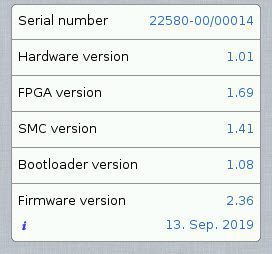Software version 2.36 for CANtouch
New measurement of Level Ratio
 The new software version from September 2019 comes with a new measured value for the CAN bus, the level ratio. This new measured value facilitates the detection of short circuits and transition resistances in a wire or between wires as well as of electronic faults in CAN nodes. The difficulty in detecting problems with certain absolute voltage levels is that similar constellations can also arise due to Common Mode. It was, therefore, necessary to find a way of reliably distinguishing permissible common-mode shifts from cases of a short circuit or contact resistance.
The new software version from September 2019 comes with a new measured value for the CAN bus, the level ratio. This new measured value facilitates the detection of short circuits and transition resistances in a wire or between wires as well as of electronic faults in CAN nodes. The difficulty in detecting problems with certain absolute voltage levels is that similar constellations can also arise due to Common Mode. It was, therefore, necessary to find a way of reliably distinguishing permissible common-mode shifts from cases of a short circuit or contact resistance.
Until now, specific errors could only be detected indirectly, for example, the short-circuit from CAN_L to ground. The problem was only visible in the physical oscilloscope image. The Automatic Quick Test was able to evaluate the bus completely thoroughly, even though a line was faulty. Due to the additional measured value level ratio, the CANtouch now reliably detects such errors.
 The level ratio describes the percentage shares of CAN_H and CAN_L in the difference signal for the dominant bus state. 100% are distributed over the two lines CAN_L and CAN_H, whereby a distribution of 50% to 50% is optimal. Deviations from the ideal occur, for example, when transition resistances or short circuits arise from a line to the supply voltage or ground. The transceivers with 3.3V power supply installed in some nodes have a negative influence on the level ratio, whereby the preset evaluation thresholds selected in such a way that this slight shift of roundabout 5% does not signal an error.
The level ratio describes the percentage shares of CAN_H and CAN_L in the difference signal for the dominant bus state. 100% are distributed over the two lines CAN_L and CAN_H, whereby a distribution of 50% to 50% is optimal. Deviations from the ideal occur, for example, when transition resistances or short circuits arise from a line to the supply voltage or ground. The transceivers with 3.3V power supply installed in some nodes have a negative influence on the level ratio, whereby the preset evaluation thresholds selected in such a way that this slight shift of roundabout 5% does not signal an error.
As is usual with the CANtouch, the evaluation limits in the cantouch.property.rating.xml file can also be set project-related for this measurement. The default setting causes the output of a warning if the share of one of the lines falls below 30%. A value below 20% is considered an error.
September 2019






